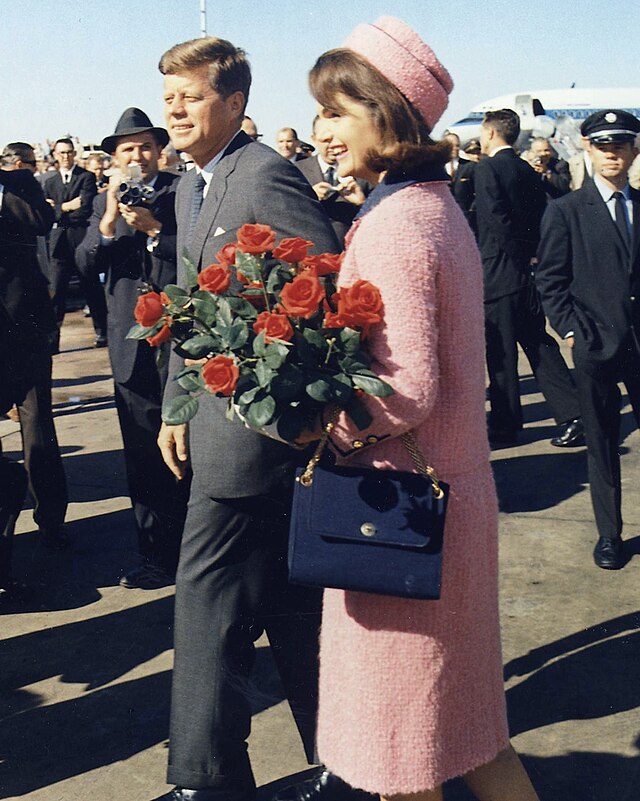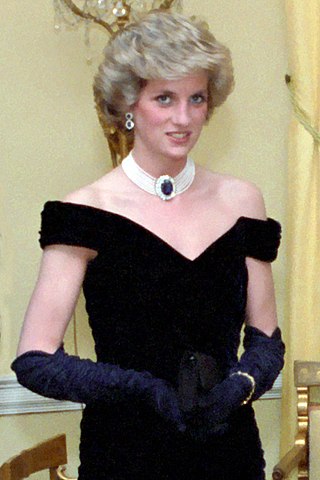Top Qs
Timeline
Chat
Perspective
Fashion icon
Influential people who introduce new styles From Wikipedia, the free encyclopedia
Remove ads
A fashion icon or fashion leader is an influential person who introduces new styles which spread throughout fashion culture and become part of fashion. They initiate a new style which others may follow. They may be famous personalities such as political leaders, celebrities, or sports personalities. For example, during the 1960s, Jacqueline Kennedy Onassis was a great fashion icon for American women, and her style became a sign of wealth, power, and distinction; and her famous Pink Chanel suit is one of the most referenced and revisited of all of her items of clothing. Twiggy was an It girl, she was a teenaged model and fashion icon of Swinging Sixties.[1][2][3][4][5]

Remove ads
Fashion leaders
Summarize
Perspective
"Fashion leaders" are an older term replaced in the second half of the 20th century. Fashion leaders were important people of higher hierarchy and society such as royalty, aristocrats and their wives and mistresses.[2]
- Queen Marie Antoinette, during her two-decade consort reign, reshaped by her influence the worlds of 18th-century fashion and design in France and Europe.[6][7]
- Empress Joséphine, the first wife of Emperor Napoleon I, was herself holding the ''Empire dress line.''[2]
- Beau Brummell, a friend of King George IV, was a fashion leader in men's fashion.[2]
- Nur Jahan, the wife of the Mughal emperor Jahangir, was a fashion enthusiast, and she was having a great interest in clothing items of that time; she set many fashion trends. Nur Jahan was very creative and had a good fashion sense, and she is credited for many textile materials and dresses like nurmahali dress and fine cloths like Panchtoliya badla (silver-threaded brocade), kinari (silver-threaded lace), etc.[8][9][10]
- Mary Quant was a famous fashion designer and fashion icon of the 1960s who introduced miniskirt. She is also attributed for hotpants, the slip dress, and PVC raincoats.[11][12]
- Diana, Princess of Wales was an English rose, a fashion leader in the 1980s and 1990s.[13]
- Carolyn Bessette-Kennedy, the wife of John F. Kennedy Jr., was a fashion icon in the late 1990s.[14][15]
Remove ads
Other style icons
Summarize
Perspective

- Anna May Wong[16]
- Josephine Baker[16]
- Marlene Dietrich
- Eva Perón
- Wallis Simpson
- Audrey Hepburn (see Fashion of Audrey Hepburn)
- Marilyn Monroe (see Marilyn Monroe in popular culture)
- Rita Hayworth
- Brigitte Bardot
- Mary Quant
- Gayatri Devi
- Princess Margaret, Countess of Snowdon
- Grace Kelly[16]
- Elizabeth Taylor[16]
- Catherine Deneuve
- Grace Jones[16]
- Diana, Princess of Wales (see Fashion of Diana, Princess of Wales)
- Madonna (see Fashion of Madonna)
- Naomi Campbell
- Kate Moss
- Carolyn Bessette-Kennedy
- Britney Spears[17]
- Lady Gaga
- Beyoncé
- Céline Dion
- Catherine, Princess of Wales (see Fashion of Catherine, Princess of Wales)
- Meghan, Duchess of Sussex[18]
- Taylor Swift (see Public image of Taylor Swift)
- Kim Kardashian[19][20]
Power dressing

Power dressing a clothing style that enables women to establish their authority and power in the traditionally male dominated profession such as politics. Margaret Thatcher's style sets the rules on how female politicians should dress, which is a conservative, powerful but simultaneously feminine way.[21]
- Margaret Thatcher was one of the first to incorporate the spirit of power suits.[22][21][23]
Remove ads
Dresses
Similar to the Little Black Dress that is associated with actress Audrey Hepburn.[3] the following dresses and garments are famous with the names of fashion icons.
- Eugénie hat, the original Eugénie hat was named after Eugénie de Montijo, wife of Napoleon III, whose fashion choices were publicized in fashion sketches and closely scrutinized across Europe and the United States.[24]
- Pink Chanel suit of Jacqueline Bouvier Kennedy
- Black Givenchy dress of Audrey Hepburn
- White dress of Marilyn Monroe
- Marilyn Monroe's pink dress
- Black dress of Rita Hayworth
- Gaultier conical corset of Madonna[25]
- Travolta dress, worn by Diana, Princess of Wales when she danced with actor John Travolta.
- Revenge dress, worn by Diana, Princess of Wales to a fundraising dinner at the Serpentine Gallery.
Quotes
"Style is not fashion until it has reached the street"[26]: 286
See also
- Model (person), a person with a role either to promote, display or advertise commercial products (notably fashion clothing in fashion shows) or to serve as a visual aid for people who are creating works of art or to pose for photography.
- Cultural icon, a person or an artifact that is identified by members of a culture as representative of that culture.
- Fashion journalism
References
Wikiwand - on
Seamless Wikipedia browsing. On steroids.
Remove ads
